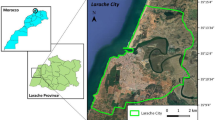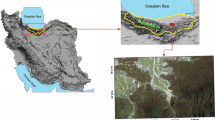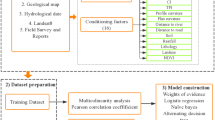Abstract
Decision tree (DT) algorithms have been applied for classification and change detection in various geospatial studies and more recently, for urban expansion and land use/land cover (LULC) change modeling. However, these studies have not elaborated on specification of DT algorithms regarding data sampling, predictor variables, model configuration, and model evaluation. The focus of this study is to explore several balanced and unbalanced sampling methods, various predictor variables, different configurations of stopping rules, and reliable evaluation metrics to enhance the performance of classification and regression tree (CART), one of the most efficacious DT algorithms, for urban expansion modeling. The implementation of the model in the Triangle Region, North Carolina (NC) State, over the period of 2001 to 2011 demonstrates a striking performance with the training accuracy of 97%, the testing accuracy of 94%, and the Kappa value of 0.80. This performance was achieved using a training dataset containing all changed land cells and three times of that randomly selected from unchanged land cells and regulating the minimum number of records in a leaf node equal to 1, the minimum number of records in a parent node equal to 2, and the value of 10,000 for the maximum number of splits. The CART DT algorithm indicates that proximity to built areas, proximity to highways, current LULC type, elevation, and distance to water bodies are the most significant predictor variables for the urban expansion prediction in the study area.






Similar content being viewed by others
References
Bhatta B (2010) Causes and Consequences of Urban Growth and Sprawl. In: Causes and consequences of urban growth and sprawl Analysis of urban growth and sprawl from remote sensing data. Springer, Berlin, Heidelberg, pp 17–36
Pradhan B (2017) Spatial Modeling and Assessment of Urban Form. Springer
Yao F, Hao C, Zhang J (2015) Simulating urban growth processes by integrating cellular automata model and artificial optimization in Binhai new area ofTianjin, China. Geocarto Int:1–16
Hosseinali F, Alesheikh AA, Nourian F (2013) Agent-based modeling of urban land-use development, case study: simulating future scenarios of Qazvin city. Cities 31:105–113
Zhang Q, Ban Y, Liu J, Hu Y (2011) Simulation and analysis of urban growth scenarios for the greater Shanghai area, China. Comput Environ Urban Syst 35(2):126–139
Hu Z, Lo CP (2007) Modeling urban growth in Atlanta using logistic regression. Comput Environ Urban Syst 31:667–688
Liao F, Wei Y (2014) Modeling determinants of urban growth in Dongguan, China: a spatial logistic approach. Stoch Env Res Risk Assess 28:801–816
Mom K, Ongsomwang S (2016) Urban growth modeling of Phnom Penh, Cambodia using satellite imageries and a logistic regression model. Suranaree J Sci Technol 23(4):481–500
Tahami H, Basiri A, Moore T, Park J, Bonenberg L (2018) Virtual spatial diversity antenna for GNSS based Mobile positioning in the harsh environments. In: Paper presented at the the 31st international technical meeting of the satellite division of the Institute of Navigation (ION GNSS+ 2018), Miami
Tayyebi A, Perry PC, Tayyebi AH (2014) Predicting the expansion of an urban boundary using spatial logistic regression and hybrid raster-vector routines with remote sensing and GIS. Int J Geogr Inf Sci 28(4):639–659
Mohammady S, Delavar MR (2016) Urban sprawl assessment and modeling using landsat images and GIS. Modeling Earth Systems and Environment 2(3):155–169
Pourebrahim N, Sultana S, Thill JC, Mohanty S (2018) Enhancing trip distribution prediction with twitter data: comparison of neural network and gravity models. Paper presented at the 2nd ACM SIGSPATIAL international workshop on AI for geographic knowledge discovery, Seattle, WA
Tayyebi A, Pijanowski BC, Tayyebi AH (2011) An urban growth boundary model using neural networks, GIS and radial parameterization: an application to Tehran, Iran. Landsc Urban Plan 100:35–44
Tian G, Ma B, Xu X, Liu X, Xu L, Liu X, Xiao L, Kong L (2016) Simulation of urban expansion and encroachment using cellularautomata and multi-agent system model—a case study of Tianjinmetropolitan region, China. Ecol Indic 70:439–450
Batty M, Xie Y, Sun Z (1999) Modeling urban dynamics through GIS-based cellular automata. Comput Environ Urban Syst 23:205–233
Clarke KC, Hoppen S, Gaydos L (1997) A self-modifying cellular automaton model of historical urbanization in the San Francisco Bay Area. Environ Plann B Plann Des 24:247–261
de Noronha Vaz E, Nijkamp P, Painho M, Caetano M (2012) A multi-scenario forecast of urban change: a study on urban growth in the Algarve. Landsc Urban Plan 104:201–211
Feng Y, Liu Y, Batty M (2016) Modeling urban growth with GIS based cellular automata and least squares SVM rules: a case study in Qingpu–Songjiang area of Shanghai, China. Stoch Env Res Risk A 30(5):1387–1400
Wu F, Martin D (2002) Urban expansion simulation of Southeast England using population surface modelling and cellular automata. Environ Plan A 34:1855–1876
Babakan AS, Taleai M (2015) Impacts of transport development on residence choice of renter households: an agent-based evaluation. Habitat Int 49:275–285
Li J, Oyanaa T, Mukwayac PI (2016) An examination of historical and future land use changes in Uganda using change detection methods and agent-based modelling. African Geographical Review 35(3):247–271
Murray-Rust D, Rieser V, Robinson DT, Miličič V, Rounsevell M (2013) Agent-based modelling of land use dynamics and residential quality of life for future scenarios. Environ Model Softw 46:75–89
Shirzadi Babakan A, Alimohammadi A (2016) An agent-based simulation of residential location choice of tenants in Tehran, Iran. Trans GIS 20(1):101–125
Shirzadi Babakan A, Alimohammadi A, Taleai M (2015) An agent-based evaluation of impacts of transport developments on the modal shift in Tehran, Iran. Journal of Development Effectiveness 7(2):230–251
Huang B, Xie C, Tay R (2010) Support vector machines for urban growth modeling. Geoinformatica 14(1):83–99
Huang B, Xie C, Tay R, Wu B (2009) Land-use-change modeling using unbalanced support-vector machines. Environ Plann B Plann Des 36:398–416
Karimi F, Sultana S, Babakan AS, Suthaharan S (2019) An enhanced support vector machine model for urban expansion prediction. Comput Environ Urban Syst 75(61-75)
Al-sharif AA, Pradhan B (2015) A novel approach for predicting the spatial patterns of urban expansion by combining the chi-squared automatic integration detection decision tree, Markov chain and cellular automata models in GIS. Geocarto Int 30(8):858–881
Samardžić-Petrović M, Dragićević S, Bajat B, Kovačević M (2015) Exploring the decision tree method for modelling urban land use change. Geomatica 69(3):313–325
Qin B, Xia Y, Li F (2009) DTU: a decision tree for uncertain data. Paper presented at the Pacific-Asia conference on knowledge discovery and data mining, Berlin, Heidelberg
Friedl MA, Brodley CE (1997) Decision tree classification of land cover from remotely sensed data. Remote Sens Environ 61(3):399–409
Pal M, Mather PM (2003) An assessment of the effectiveness of decision tree methods for land cover classification. Remote Sens Environ 86(4):554–565
Debeljak M, Dzeroski S (2011) Decision trees in ecological modeling Modeling Complex Ecological Dynamics. Springer, pp 197–209
Delen D, Kuzey C, Uyar A (2013) Measuring firm performance using financial ratios: a decision tree approach. Expert Syst Appl 40(10):3970–3983
Quinlan JR (1993) C4. 5: programs for machine learning. Morgan Kaufmann, San Francisco
Shafizadeh-Moghadam H, Asghari A, Tayyebi A, Taleai M (2017) Coupling machine learning, tree-based and statistical models with cellular automata to simulate urban growth. Comput Environ Urban Syst 64:297–308
Samardžić-Petrović M, Kovačević M, Bajat B, Dragićević S (2017) Machine learning techniques for modelling short term land-use change. ISPRS Int J Geo Inf 6(12):387
Tayyebi A, Pijanowski BC (2014) Modeling multiple land use changes using ANN, CART and MARS: comparing tradeoffs in goodness of fit and explanatory power of data mining tools. Int J Appl Earth Obs Geoinf 28:102–116
Jarvis, C., & Raynor, D. (2018). Seven Triangle towns are among the state's fastest-growing, and then there's Garner. Retrieved from https://www.newsobserver.com/news/local/article211599389.html. Accessed Sep 2018
USGS. (2017). 3DEP products and services: The National Map. U.S. Geological Survey, The National Map, 3D Elevation Program Web page. Retrieved from https://nationalmap.gov/3DEP/3dep_prodserv.html. Accessed Sep 2018
Abbott MP (2018) North Carolina's research Triangle Park: a success story of private industry fostering public investment to create a homegrown Commercial Park. Campbell Law Review 40(2):569
Cummings AS (2017) “Brain magnet”: research Triangle Park and the origins of the Creative City, 1953-1965. J Urban Hist 43(3):470–492
Pauleit S, Ennos R, Golding Y (2005) Modeling the environmental impacts of urban land use and land cover change-a study in Merseyside, UK. Landsc Urban Plan 71(2–4):295–310
News and Records. (2018). Retrieved from https://www.greensboro.com/uploaded_pdfs/w-nws-census-p/pdf_35e11ba5-4daf-5ed0-8be6-bfcd8bc729ee.html. Accessed Sep 2018
Musa SI, Hashim M, Reba MNM (2017) A review of geospatial-based urban growth models and modelling initiatives. Geocarto Int 32(8):813–833
Shirzadi A, Taleai M, Alimohammadi A (2013) Public transportation mode selection in an urban corridor: application of multi-criteria decision making methods. Urban-Regional Studies and Research Journal 5(18):1–6
Kim Y, Street WN, Menczer F (2003) Feature selection in data mining. In: Wang J (ed) Data mining: opportunities and challenges. Idea Group, Hershey, pp 80–105
Rokach, L., & Maimon, O. Z. (2008). Data mining with decision trees: theory and applications (Vol. 69)
Homer C, Dewitz J, Yang L, Jin S, Danielson P, Xian G et al (2015) Completion of the 2011 National Land Cover Database for the conterminous United States-representing a decade of land cover change information. Photogramm Eng Remote Sens 81(5):345–354
U. S. Census Bureau. (2018). TIGER/Line Shapefiles and TIGER/Line Files. Retrieved from https://www.census.gov/geographies/mapping-files/time-series/geo/tiger-line-file.html. Accessed Sep 2018
Willekens F (2005) Biographic forecasting: bridging the micro-macro gap in population forecasting. New Zealand Population Review 31(1):77–124
IPUMS-USA. (2018). Retrieved from www.ipums.org. Accessed Sep 2018
Suthaharan S (2016) Machine learning models and algorithms for big data Classifi cation, vol 36. Springer, New York
Tan PN, Steinbach M, Kumar V (2006) Classification: basic concepts, decision trees, and model evaluation. Introduction to Data Mining 1:145–205
Breiman L, Friedman JH, Olshen RA, Stone CJ (1984) Classification and regression trees. Chapman & Hall, New York
Singh S, Gupta P (2014) Comparative study ID3, cart and C4. 5 decision tree algorithm: a survey. International Journal of Advanced Information Science and Technology (IJAIST) 27(27):97–103
Song YY, Ying LU (2015) Decision tree methods: applications for classification and prediction. Shanghai Arch Psychiatry 27(2):130
Witten IH, Frank E (2005) Data mining: practical machine learning tools and techniques. Morgan Kaufmann, Burlington
Cohen J (1960) A coefficient for agreement for nominal scales. Educ Psychol Meas 20(37–46):37–46
Fleiss JL, Levin B, Paik MC (2013) Statistical methods for rates and proportions. John Wiley & Sons, New York
Samardzić-Petrović M, Dragić Ević S, Kovacevic MS, Bajat B (2016) Modeling urban land use changes using support vector machines. Trans GIS 20(5):718–734
Tahami H, Park J, Choi Y (2017) The Preliminary Study on the Prediction of a Hurricane Path by GNSS Derived PWV Analysis. Paper presented at the Proceedings of the ION 2017 Pacific PNT meeting, Honolulu
Author information
Authors and Affiliations
Corresponding author
Additional information
Publisher’s note
Springer Nature remains neutral with regard to jurisdictional claims in published maps and institutional affiliations.
Rights and permissions
About this article
Cite this article
Karimi, F., Sultana, S., Babakan, A.S. et al. Urban expansion modeling using an enhanced decision tree algorithm. Geoinformatica 25, 715–731 (2021). https://doi.org/10.1007/s10707-019-00377-8
Received:
Revised:
Accepted:
Published:
Issue Date:
DOI: https://doi.org/10.1007/s10707-019-00377-8




